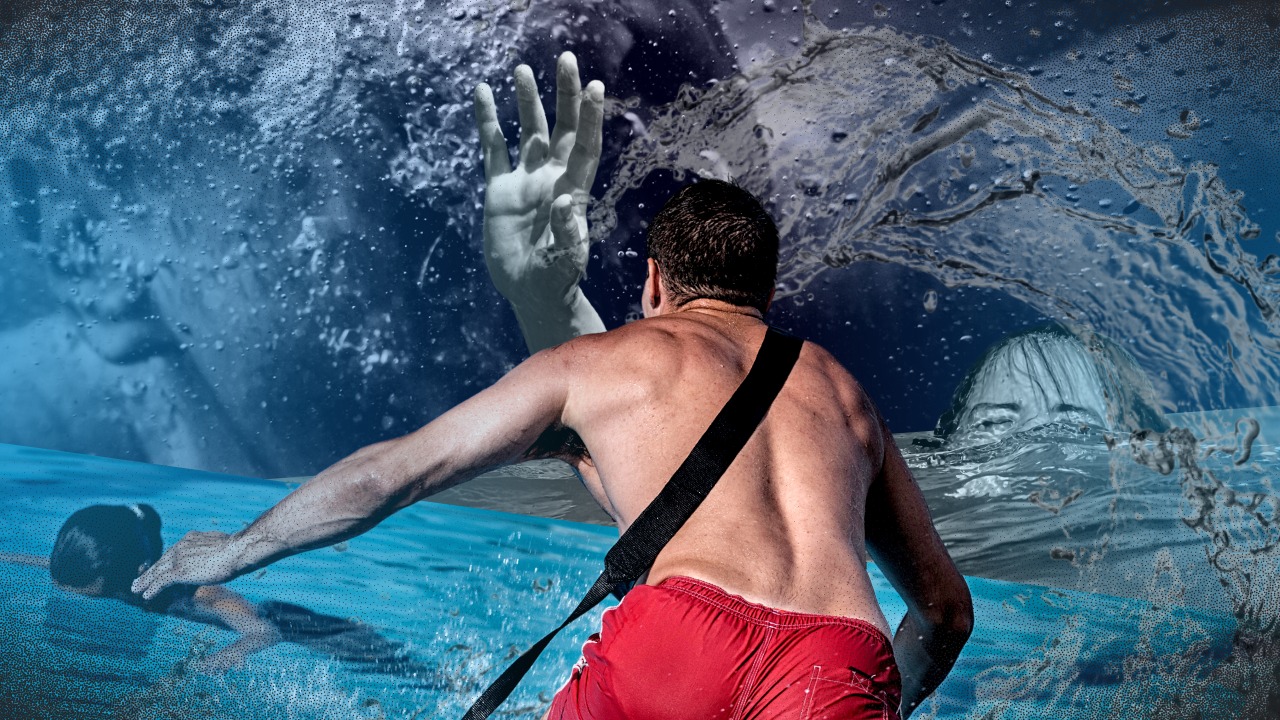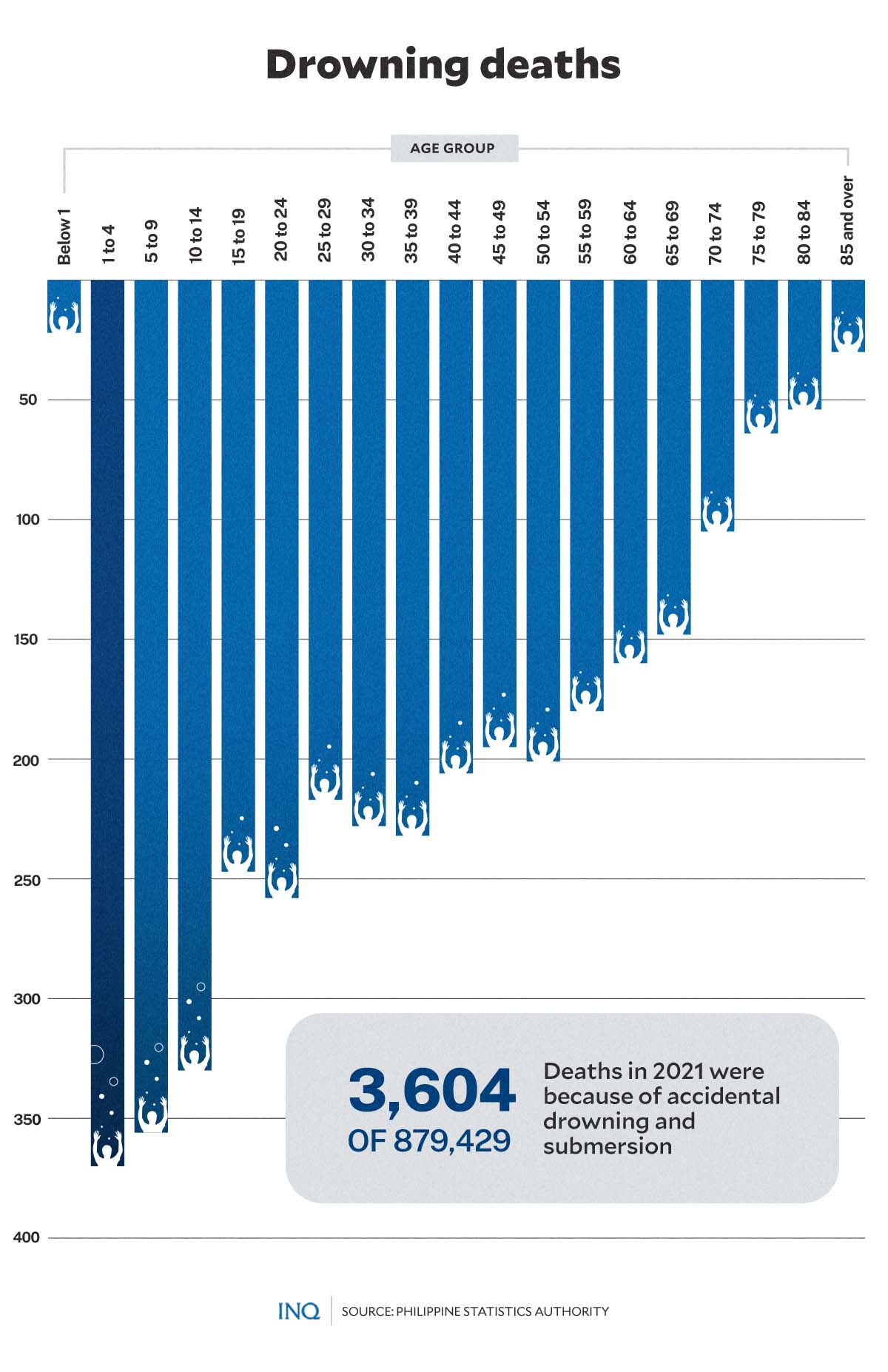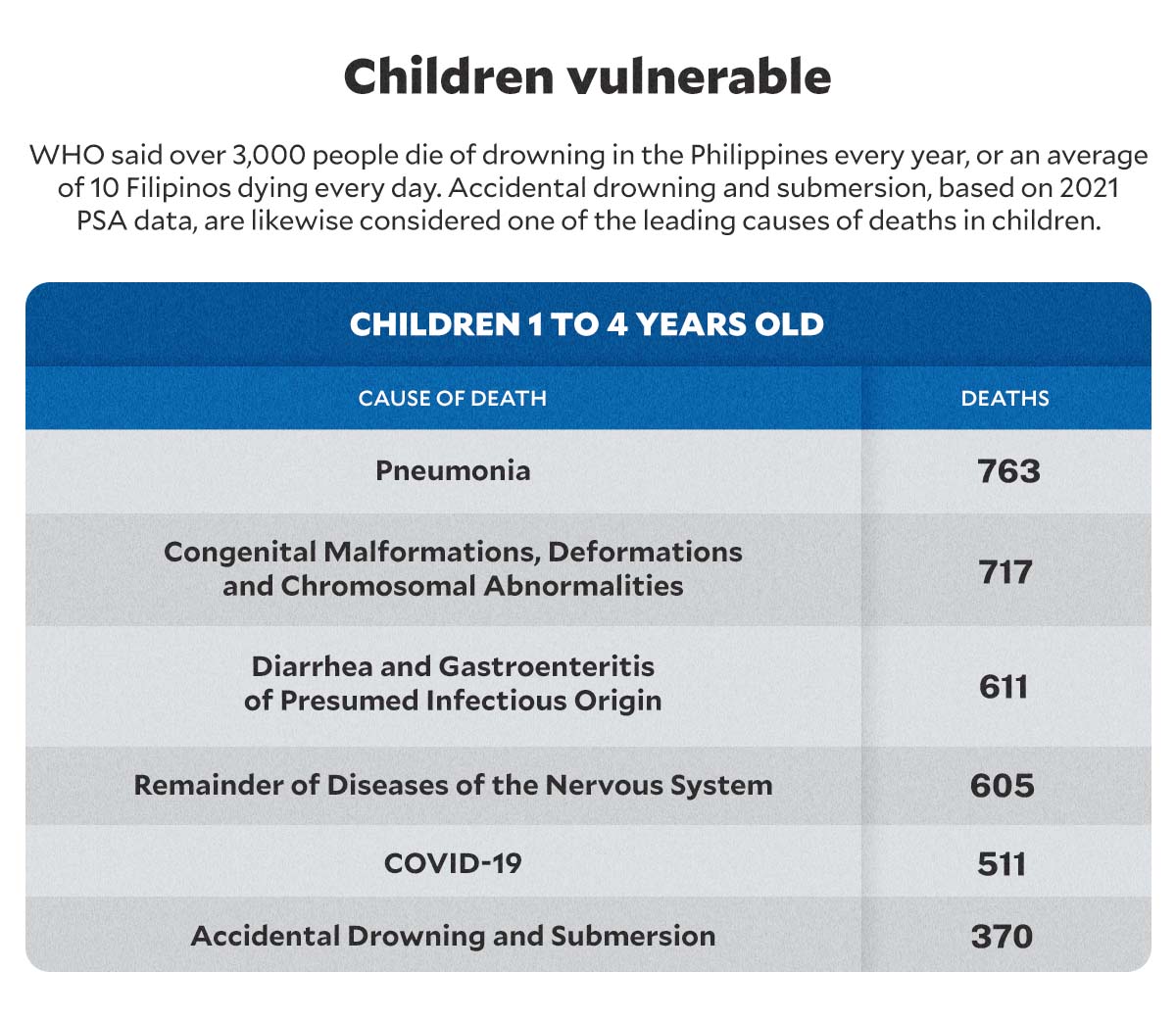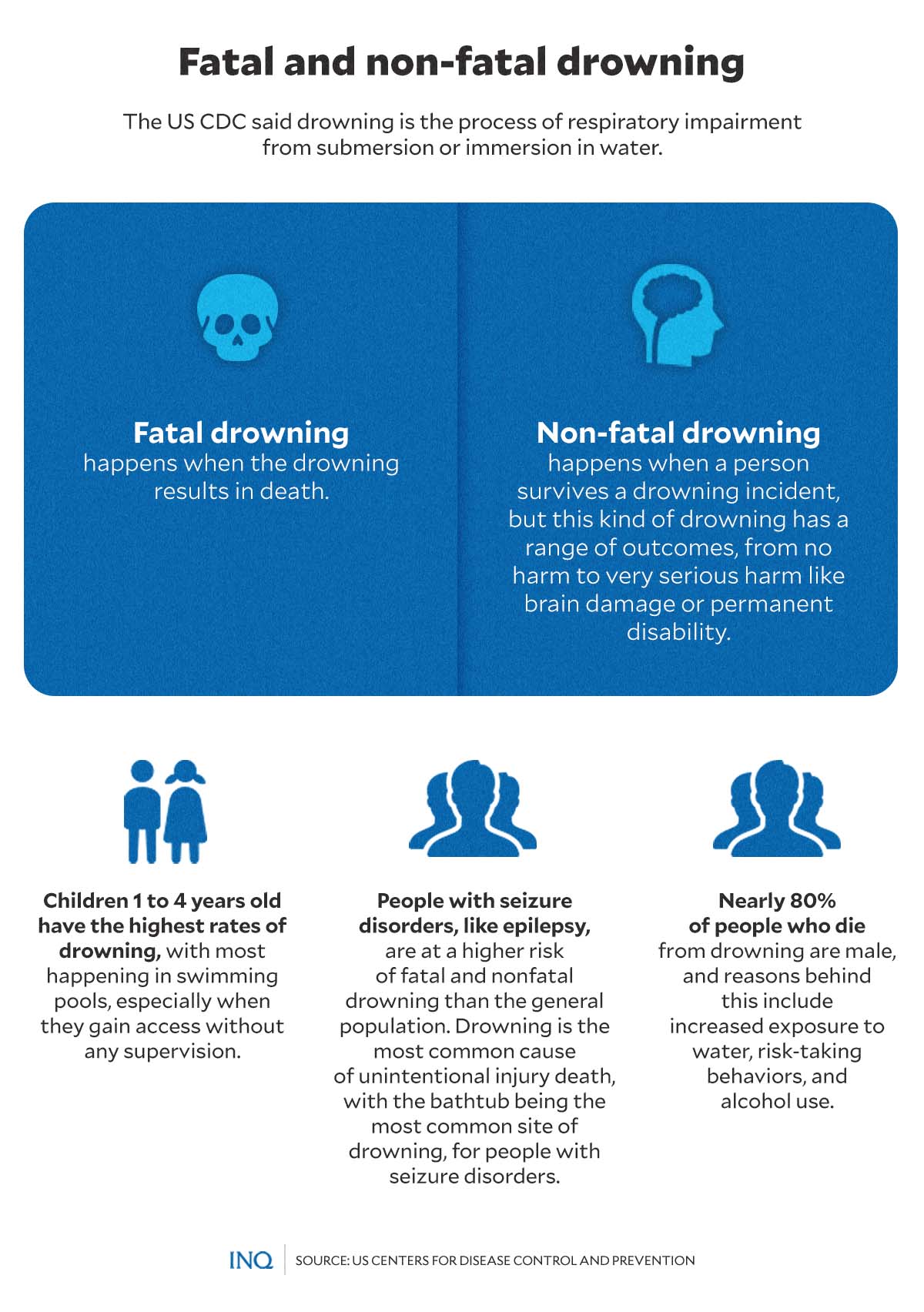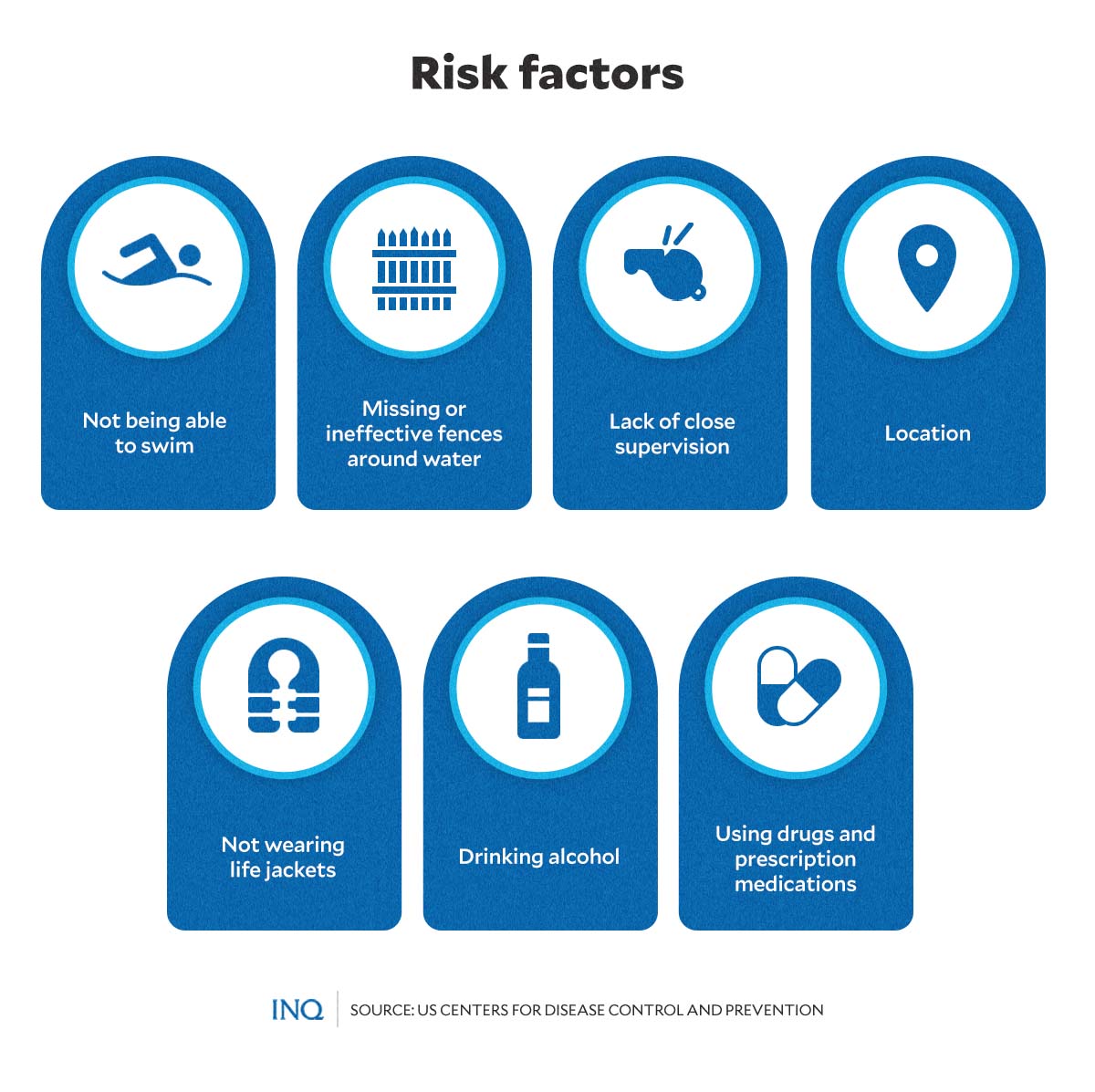Drowning, a ‘serious public health issue,’ makes Holy Week break tragic for some
MANILA, Philippines—With the long weekend, thousands of Filipinos spent the Holy Week in beaches, rivers and pools, but what should have been a convenient celebration ended tragic for some.
Col. Jean Fajardo said over Teleradyo on Monday (April 10) that since April 1, the Philippine National Police (PNP) has recorded 67 drowning cases all over the country.
She said 72 individuals died, stressing that in some cases, there were multiple deaths, like what happened to a family of three in Isabela, where a 42-year-old father and his 16-year-old and 8-year-old sons died.
Then in Batangas, five people, most of them students, also drowned. The police said the victims were walking on a shallow part of the sea in Barangay Sambal Ilaya in Lemery town when they suddenly got into the deep part of the water, causing them to sink together.
Five people also died of drowning in San Jose, Camarines Sur. The police said the victims were swimming off a beach in Barangay Dolo when they encountered big waves. The body of another victim who went missing was retrieved last April 8.
READ: Body of drowning victim in Camarines Sur found after 6-hour search
Fajardo, PNP spokesperson, said 72 deaths as of 6 p.m. on Sunday were higher than last year’s, stressing that most of the cases were in Ilocos Region, Central Luzon, and Calabarzon.
READ: Holy Week death toll reaches 21 in Luzon
Serious issue
While Fajardo recognized that cases peak throughout the Holy Week, when thousands of people go out for vacation, drowning has long been considered a serious issue in the Philippines.
Last year, World Health Organization (WHO) officer Dr. John Go was quoted by the Philippine Information Agency as saying that drowning is “one of the important public health issues but often not adequately addressed in our communities and the country.”
Based on 2021 data from the Philippine Statistics Authority (PSA), out of the 879,429 deaths that year, 3,604 were classified as deaths because of accidental drowning and submersion.
RELATED STORY: Several deaths due to drowning recorded on Holy Week — PCG
With 370 deaths, children 1 to 4 years old had most of the cases, followed by children 5 to 9 years old (356), 10 to 14 years old (330), 20 to 24 years old (258), 15 to 19 years old (247), and 35 to 39 years old (232).
Go said that in the Philippines, over 3,000 people die of drowning every year, or an average of 10 Filipinos a day. Accidental drowning and submersion are likewise considered one of the leading causes of deaths among children.
Back in 2021, drowning was the second leading cause of death among children 5 to 9 years old, next to diseases of the nervous system, which claimed the lives of 488 children in that age group that year.
Then among children 1 to 4 years old, it was the sixth leading cause of death, next to COVID-19 (511), diseases of the nervous system (605), diarrhea and gastroenteritis of presumed infectious origin (611), congenital malformations, deformations and chromosomal abnormalities (717), and pneumonia (763).
Accidental drowning and submersion were also the second leading cause of death among children 10 to 14 years old, next to diseases of the nervous system, which was the reason for the death of over 500 people in that age group in 2021.
Water-related hazard
As stressed by WHO, drowning, and even impact injury, specifically head and spinal injuries, are considered the most common health hazards in recreational waters, like beaches, rivers and pools.
RELATED STORY: 5 drown, 1 missing in Camarines Sur beach
It estimated that yearly, there are 236,000 drowning deaths all over the world. Accounting for 7 percent of all injury-related deaths, the WHO said drowning is the third leading cause of unintentional injury death globally.
WHO said the global burden and death from drowning are seen in all economies and regions, but low- and middle-income countries account for over 90 percent of unintentional drowning deaths.
Likewise, over half of the world’s drowning happens in the Western Pacific and Southeast Asia regions, with death rates being the highest in the former, and are 27 to 32 times higher than those seen in the United Kingdom or Germany, respectively.
The group Stop Drowning Now said all over the world, the highest drowning rates are among children 1 to 4 years old and children 5 to 9 years old, and that males are especially at risk of drowning, with twice the overall mortality rate of females.
The US Centers for Disease Control and Prevention (CDC) said most drownings in children happen in pools and that drowning can happen even when children are not expected to be near water, such as when they gain access to pools without any supervision.
As it explained , almost 80 percent of people who die from drowning are male, and reasons behind this include increased exposure to water, risk-taking behaviors, and alcohol use.
Based on PSA data, which was released last Feb. 24, 2,877 males died of accidental drowning and submersion in 2021, way higher than among females, which only saw 727 deaths.
The US CDC said people with seizure disorders, such as epilepsy, are also at a higher risk of fatal and non-fatal drowning than the general population, with the bathtub being the most common site of drowning, for people with seizure disorders.
How victims get drowned
Drowning is the process of respiratory impairment from submersion or immersion in water, and can be classified as fatal, when the drowning results in death, or non-fatal, when a person survives drowning.
However, even when non-fatal, the US CDC explained that drowning has a range of outcomes, from no harm to very serious harm such as brain damage or permanent disability.
WHO said drowning may happen when an individual is caught in a tide or rip current, is trapped by rising tides, falls overboard from a boat, becomes trapped by submerged obstacles, or falls asleep on an inflatable mattress and is carried out to sea.
Then in swimming pools and spas, “drowning or near-drowning and other injuries may occur close to outlets where suction is strong enough to catch body parts or hair so that the head is trapped underwater.”
As explained by the medical website Healthline, drowning is a form of death by suffocation. Death occurs after the lungs take in water: “This water intake then interferes with breathing.”
This, as when lungs take in water, they become heavy, and oxygen stops being delivered to the heart. Without the supply of oxygen, the body shuts down. The average person can hold their breath for around 30 seconds. For children, the length is even shorter.
A person who’s in excellent health and has training for underwater emergencies can still usually hold their breath for only 2 minutes, “but the health event we know as drowning only takes a couple of seconds to occur.”
If a person is submerged after breathing in water for 4 to 6 minutes without resuscitation, it will result in brain damage and eventually death by drowning, Healthline explained.
Risk factors
The US CDC said there are risk factors that make drowning more likely such as these:
- Not being able to swim
- Missing or ineffective fences around water
- Lack of close supervision
- Location
- Not wearing life jackets
- Drinking Alcohol
- Using drugs and prescription medications
Stop Drowning Now said “understanding how to prevent leading causes of child injury, like drowning, is a step toward keeping children safe,” stressing that “it’s great to enjoy time at the pool or beach, but it’s important to remember that drownings are a leading cause of injury death for young children ages one to 14.
It said adults can play a crucial role in protecting children from drowning by learning these key prevention tips:
- Life-saving skills
Everyone should know the basics of swimming and cardiopulmonary resuscitation.
- Learn to swim
Learning to swim can reduce the risk of drowning by 88 percent for 1 to 4-year-olds who take formal swim lessons.
- Barriers work
Four-sided isolation fences, with self–closing and self–latching gates, around backyard swimming pools can help keep children away from the area when they aren’t supposed to be swimming. Pool fences should completely separate the house and play area from the pool.
- Wear life jackets
Make sure kids wear life jackets in and around natural water bodies, such as lakes or the ocean, even if they know how to swim. Life jackets can be used in and around pools for weaker swimmers too.
- Stay Vigilant
Close supervision is required when kids are in or near water at all times. Drowning happens quickly and quietly, so adults watching kids in or near water should avoid distracting activities like playing cards, reading books, talking on the phone and using alcohol or drugs.
RELATED STORY: Unwinding safely during vacations: Tips from experts
